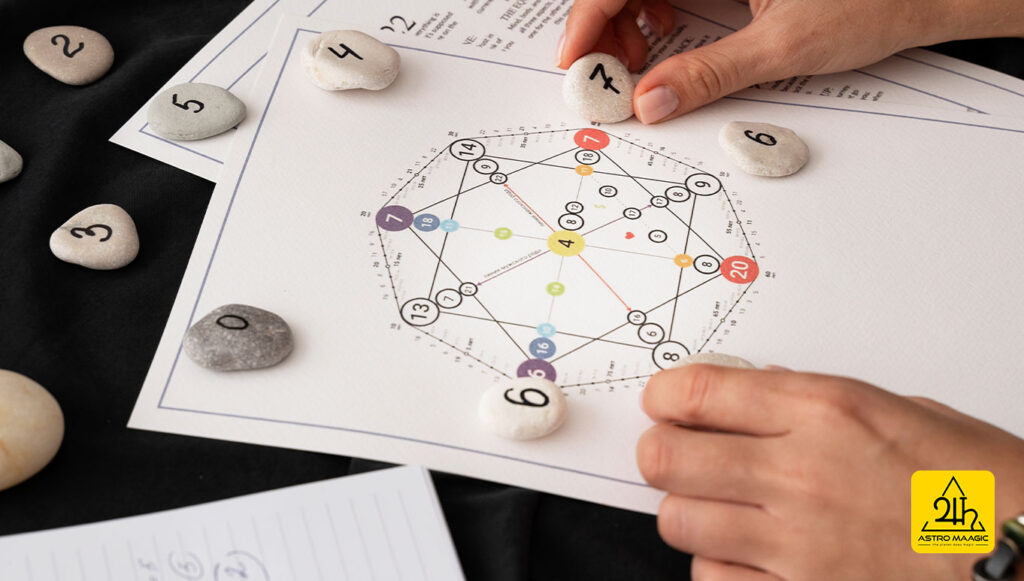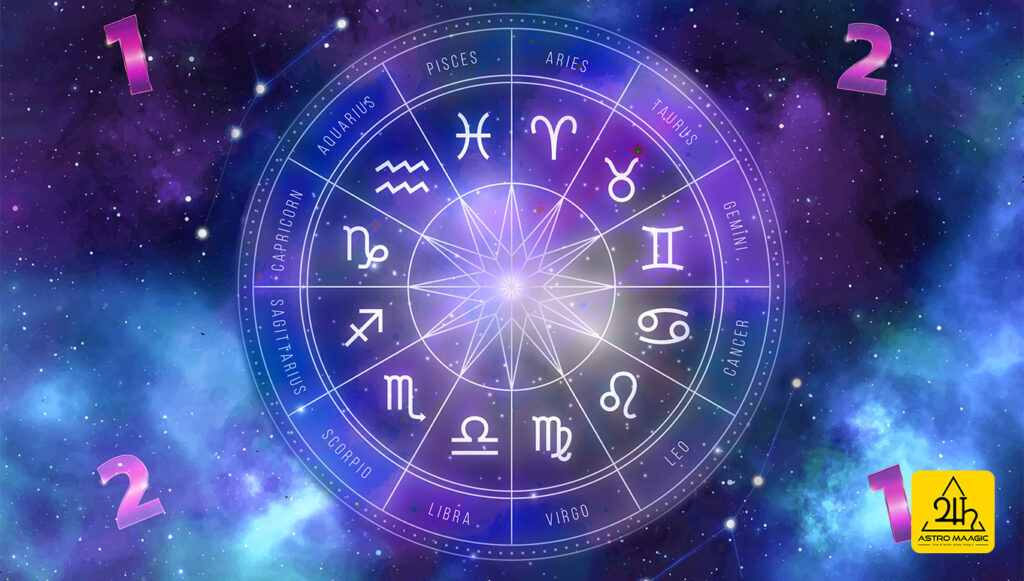What to Know About Hindu Astrology?
- What to Know About Astrology?
- History and Origin of Hindu Astrology
- Core Principles of Hindu Astrology
- Free Will vs. Destiny
- Components of a Janma Kundali (Birth Chart)
- 12 Houses (Bhavas) and Their Meanings
- 9 Planets (Navagrahas) in Vedic Astrology
- 12 Zodiac Signs (Rashis) and Their Characteristics
- The Importance of Nakshatras (Lunar Mansions)
- Types of Hindu Astrology
- Conclusion
- FAQs on Hindu Astrology

Astrology is an ancient science concerned with observing the movement of celestial bodies like planets and stars and their influence on the human mind and life itself. For thousands of years, people have sought advice from astrology to study themselves and make critical judgments about areas of life such as vocation, marriage, health, and finance.
Astrology maintains a place of special prominence in India. Jyotish Shastra, Hindu or Vedic astrology, is deeply ingrained in the Vedas, the sacred texts of ancient India. It is not just belief; it has been time-tested for people, affecting their day-to-day activities. Starting auspicious muhurat for any new undertaking and seeking compatibility with the horoscope for marriage, astrology holds an important place in the culture and traditions of India
History and Origin of Hindu Astrology
Hindu astrology, also known as Jyotish Shastra, has its roots in ancient Indian traditions. The word Jyotish means “science of light.” It refers to the knowledge of how the light of celestial bodies influences life on Earth. This sacred science was gifted to humanity by ancient India’s great sages (rishis), who were blessed with deep wisdom and divine insight.
One of the most respected sages in Vedic astrology is Maharishi Parashara. He is believed to have compiled the knowledge of astrology in the famous text Brihat Parashara Hora Shastra, which remains a foundation for Vedic astrologers even today. Another important sage is Maharishi Bhrigu, known for the Bhrigu Samhita, a collection of ancient astrological predictions. These texts guide astrologers in understanding planetary influences and making accurate predictions.
Astrology is also mentioned in some of the oldest scriptures of India. The Rigveda, one of the four Vedas, refers to planetary movements and their significance. Jyotish Vedanga, one of the six limbs of the Vedas, deals specifically with astrology and astronomy. It was considered essential knowledge for performing rituals and understanding cosmic order.
Core Principles of Hindu Astrology
Hindu astrology, or Jyotish Shastra, is based on certain core principles that help explain life’s events and experiences. These principles are deeply connected to the ideas of karma, time, and the movements of celestial bodies.
Karma and Its Influence
At the heart of Hindu astrology is the concept of karma. It is believed that our actions both in this life and past lives create karmic results that shape our current experiences. Astrology helps us understand the effects of these karmas. The birth chart (Janma Kundali) shows the placement of planets at the time of birth, revealing the karmic patterns we carry. By studying the chart, an astrologer can offer guidance on facing challenges and making the most of opportunities.
The Concept of Time (Kala) and Planetary Movements
Time, or Kala, is considered divine in Hindu philosophy. Astrology divides time into various cycles, from days to centuries. Planetary movements are seen as indicators of time’s influence on life. As the planets (Grahas) move through different signs and houses, they change different areas of our life. Accurate timing is very important in astrology, whether for predicting events or finding the best time (muhurat) for important actions.
Planets (Grahas), Houses (Bhavas), and Signs (Rashis)
There are nine main planets (Navagrahas) in Vedic astrology: the Sun, Moon, Mars, Mercury, Jupiter, Venus, Saturn, and the shadow planets Rahu and Ketu. Each planet represents specific energies and influences.
The zodiac is divided into 12 signs (Rashis) and 12 houses (Bhavas). The signs show a person’s natural tendencies, while the houses represent different areas of life like health, family, career, and marriage. The planets, signs, and houses completely picture an individual’s life.
Influence of Nakshatras and Dasas
The Nakshatras (27 lunar constellations) play a key role in Vedic astrology. They offer deeper insights into a person’s character and life path.
The Dasa system is a unique method in Vedic astrology to predict the timing of life events. It divides a person’s life into different periods ruled by specific planets, showing when certain karmic effects will manifest.
Free Will vs. Destiny
Hindu astrology respects destiny (based on past karma) and free will. While the birth chart shows the path carved by destiny, how we walk that path is our choice. Understanding astrology gives us the wisdom to make better decisions and improve our karma.
Components of a Janma Kundali (Birth Chart)
A Janma Kundali, or birth chart, is the most important tool in Hindu astrology. It is a map of the sky at the exact moment of a person’s birth, showing the positions of the planets and other celestial points. The Kundali gives insight into a person’s personality, life path, strengths, challenges, and future events. In Hindu culture, preparing a Kundali at birth is common and is often consulted before making major life decisions.
How a Kundali Is Made?

A Janma Kundali is prepared using three key details:
- Date of birth
- Time of birth
- Place of birth
These details help an astrologer calculate the exact positions of the planets in the twelve zodiac signs (Rashis) and twelve houses (Bhavas) at the time of birth. Even a small difference in time or location can significantly change the Kundali, so accurate information is crucial.
Lagna (Ascendant), Rashi Chart, and Navamsa Chart
The Lagna, or Ascendant, is the zodiac sign that was rising on the eastern horizon at the time of birth. It acts as the starting point of the birth chart and represents the individual’s outward personality and approach to life.
The Rashi Chart (main birth chart) shows the placement of planets in different signs and houses. The Navamsa Chart is another important chart that provides deeper insight, especially about marriage, partnerships, and spiritual growth. It helps refine the predictions made from the main chart.
Importance of Planetary Positions at Birth
The position of each planet at birth influences different areas of life. For example, the Moon shows the mind and emotions, while the Sun represents the soul and ego. The combination of these placements forms a unique blueprint for one’s life.
12 Houses (Bhavas) and Their Meanings

In Hindu astrology, the Kundali is divided into 12 houses, Bhavas. Each house represents a specific area of life, starting from the self and extending to relationships, careers, wealth, and beyond. The planets in these houses and their strengths help astrologers understand different aspects of a person’s life.
1. First House – Self (Lagna Bhava)
This is the house of personality, physical appearance, health, and overall life direction. It shows how a person presents themselves to the world.
2. Second House – Wealth and Family (Dhana Bhava)
It governs finances, family values, speech, and early childhood. It indicates one’s ability to accumulate wealth.
3. Third House – Siblings and Courage (Sahaja Bhava)
This house represents siblings, communication, courage, short travels, and efforts. It shows one’s willpower and energy to take action.
4. Fourth House – Home and Mother (Sukha Bhava)
It relates to home life, mother, property, real estate, vehicles, and emotional comfort.
5. Fifth House – Education and Children (Putra Bhava)
It governs intelligence, creativity, education, love affairs, and children. It also shows the potential for fame and recognition.
6. Sixth House – Health and Enemies (Roga Bhava)
This house deals with health issues, diseases, enemies, debts, and service. It shows how a person handles obstacles.
7. Seventh House – Marriage and Partnerships (Kalatra Bhava)
It represents marriage, spouse, partnerships, and business contracts. It indicates one’s ability to form committed relationships.
8. Eighth House – Longevity and Transformation (Ayushya Bhava)
This house governs longevity, sudden events, inheritance, occult knowledge, and transformation.
9. Ninth House – Luck and Dharma (Dharma Bhava)
It shows luck, fortune, religion, ethics, higher learning, and long journeys. It also reflects the person’s spiritual inclination.
10. Tenth House – Career and Status (Karma Bhava)
This is the house of profession, public image, fame, and social responsibilities. For example, a strong tenth house can indicate a successful career.
11. Eleventh House – Gains and Desires (Labha Bhava)
It represents gains, income, achievements, friendships, and fulfilment of desires.
12. Twelfth House – Loss and Liberation (Vyaya Bhava)
This house governs losses, expenses, foreign travels, spirituality, and liberation (Moksha).
Each house is interconnected. For instance, the tenth house predicts career success, but planets influence its results in the second (wealth) and eleventh (gains) houses.
9 Planets (Navagrahas) in Vedic Astrology
In Hindu astrology, the Navagrahas (nine planets) play a key role in shaping a person’s life, character, and destiny. Each planet has its energy, nature, and influence. These planets are either benefic (favourable) or malefic (challenging), depending on their placement in a person’s birth chart (Janma Kundali).
Sun (Surya)
The Sun is considered the soul (Atma), representing authority, leadership, health, and vitality. It is generally a malefic planet but gives positive results when strong.
Moon (Chandra)
The Moon governs the mind, emotions, and intuition. It signifies mental peace and motherly love. When strong, it is a benefic planet, bringing calmness and sensitivity.
Mars (Mangal)
Mars represents energy, courage, strength, and aggression. It is a malefic planet that can cause conflicts but also bring confidence and bravery when well-placed.
Mercury (Budh)
Mercury controls intelligence, communication, and business skills. It is generally beneficial but can be malefic if associated with malefic planets.
Jupiter (Guru)
Jupiter is the teacher of gods and signifies wisdom, knowledge, spirituality, and wealth. It is the most beneficial planet, bringing growth and good fortune.
Venus (Shukra)
Venus represents love, beauty, relationships, and material comforts. It is beneficial, giving artistic talents and luxuries.
Saturn (Shani)
Saturn teaches discipline, hard work, and patience. It is considered a strong malefic but can be rewarded with great success after struggle and effort.
Rahu
Rahu is a shadow planet that creates illusions, desires, and material attachments. It can confuse but also cause sudden gains in certain conditions.
Ketu
Ketu is another shadow planet that brings detachment, spirituality, and liberation. It is malefic but encourages spiritual growth when positive.
Queries about Astrological Remedies
- Fasting: Enhances energy by promoting self-discipline and purification.
- Breathing Exercises: Special breathing techniques to channel and strengthen life force.
- Vow of Silence: Temporary silence for inner reflection and heightened awareness.
- Nature Walks: Connects with natural energies for rejuvenation and balance.
- Selfless Creativity: Engaging in creative pursuits without personal gain.
- Rejoicing from the Heart: Cultivating genuine joy to uplift personal energy.
- Selfless Help: Assisting others without expecting anything in return.
- Manifestation of Modesty: Practicing humility to align with positive energies.
- Prayer before Eating: Expressing gratitude and positive intentions before meals.
- Pranic Foods: Consuming foods rich in life energy for vitality.
- Optimal Sleep Timing: Sleeping from 9 to 10 PM until 3 AM for restorative rest.
- Cold Water Dousing: Morning cold water rituals for invigoration.
- Donations of Time and Food: Offering time and food to those in need.
- Lighting Ghee Diya: Lighting a ghee lamp for well-being and gratitude.
- Sun (Sandalwood Paste): Strengthens Sun’s influence and positive traits.
- Moon (Incense Sticks): Enhances Moon’s calming energies.
- Mars (Kum Kum): Mitigates malefic Mars effects.
- Mercury (Camphor): Alleviates Mercury-related challenges.
- Jupiter (Amber): Amplifies Jupiter’s benevolent impact.
- Venus (Lavanga): Balances and supports Venus’s energies.
- Saturn (Karumuli): Neutralizes Saturn’s adverse effects.
- Rahu (Mustard): Counters negative influences of Rahu.
- Ketu (Vermilion): Provides remedies for Ketu-related issues.
- Daily Mantra Recitation: Regular chanting, especially Gayathri, for positive vibrations.
- Temple Worship (Sundays, Thursdays): Temple visits and prayers on auspicious days.
- Charitable Acts: Offering food and clothing to the less fortunate.
- Tulasi Watering: Morning ritual of watering the sacred Tulasi plant.
- Camphor Lighting: Sunset practice of lighting camphor in living spaces.
- Feeding Animals (Crows, Ants): Symbolic gestures to balance planetary influences.
- Devotional Readings: Reciting sacred texts like Hanuman Chalisa and others.
- Acts of Kindness: Helping those in need with pure intentions.
Impact on Human Life
The Navagrahas influence various aspects of life, such as health, wealth, relationships, and career. Their placement and strength in the Kundali decide life’s ups and downs.
Remedies for Planetary Afflictions
Traditional remedies include chanting mantras, wearing gemstones, performing pujas, and charity to reduce negative effects. For example, chanting the Hanuman Chalisa is believed to calm Mars, while Shani puja helps reduce Saturn’s challenges.
12 Zodiac Signs (Rashis) and Their Characteristics
In Hindu astrology, the 12 Rashis, or zodiac signs, form the foundation of a person’s Janma Kundali (birth chart). Each sign represents certain personality traits, strengths, and weaknesses and is ruled by a specific planet. These Rashis influence how the planets express their energies in a person’s life.
Mesha (Aries)
• Ruling Planet: Mars
• Traits: Courageous, energetic, independent
• Weakness: Impulsive, impatient
Vrishabha (Taurus)
• Ruling Planet: Venus
• Traits: Patient, reliable, practical
• Weakness: Stubborn, materialistic
Mithuna (Gemini)
• Ruling Planet: Mercury
• Traits: Communicative, curious, adaptable
• Weakness: Inconsistent, restless
Karka (Cancer)
• Ruling Planet: Moon
• Traits: Emotional, caring, intuitive
• Weakness: Moody, sensitive
Simha (Leo)
• Ruling Planet: Sun
• Traits: Confident, generous, leader
• Weakness: Proud, dominating
Kanya (Virgo)
• Ruling Planet: Mercury
• Traits: Practical, analytical, disciplined
• Weakness: Overcritical, perfectionist
Tula (Libra)
• Ruling Planet: Venus
• Traits: Balanced, diplomatic, fair
• Weakness: Indecisive, people-pleasing
Vrischika (Scorpio)
• Ruling Planet: Mars (Ketu in some traditions)
• Traits: Intense, determined, passionate
• Weakness: Secretive, possessive
Dhanu (Sagittarius)
• Ruling Planet: Jupiter
• Traits: Optimistic, adventurous, philosophical
• Weakness: Blunt, overconfident
Makara (Capricorn)
• Ruling Planet: Saturn
• Traits: Disciplined, hardworking, responsible
• Weakness: Reserved, pessimistic
Kumbha (Aquarius)
• Ruling Planet: Saturn (Rahu in some traditions)
• Traits: Innovative, humanitarian, independent
• Weakness: Detached, unpredictable
Meena (Pisces)
• Ruling Planet: Jupiter
• Traits: Compassionate, spiritual, artistic
• Weakness: Escapist, overly emotional
How Rashis Affect Predictions?
The placement of planets in these Rashis shapes an individual’s nature and destiny. For example, if Jupiter is in Dhanu Rashi, it strengthens wisdom and good fortune. Each sign modifies how a planet gives its results in the birth chart.
The Importance of Nakshatras (Lunar Mansions)
In Hindu astrology, the Nakshatras are 27 sky divisions, each representing a group of stars. The Moon travels through these Nakshatras, and the one where the Moon is placed at the time of birth is known as a person’s Janma Nakshatra. Nakshatras are essential to Vedic astrology, offering deep insights into personality, behaviour, and destiny.
The 27 Nakshatras
Some well-known Nakshatras include Ashwini, Bharani, Rohini, Mrigashira, and Pushya. Each Nakshatra has its ruling deity, planet, symbol, and specific qualities. For example, Rohini Nakshatra, ruled by the Moon, is known for beauty and charm, while Moola Nakshatra, ruled by Ketu, is linked with deep transformation and research.
How Nakshatras Impact Personality and Destiny
A person’s Nakshatra influences their nature, talents, strengths, and challenges in life. It shapes their emotional makeup and how they interact with the world. For example, those born in Ashwini Nakshatra are energetic and pioneering, while those under Anuradha Nakshatra are friendly and devoted.
Nakshatras are also crucial in predicting life events, health tendencies, career choices, and spiritual inclinations. Astrologers study the Nakshatra to provide detailed guidance.
Types of Hindu Astrology
Hindu astrology, also known as Jyotish Shastra, has several branches, each offering a unique method of interpreting the stars and planets. Below are some of the main types of Hindu astrology that are still practised today:
1. Parashari Astrology
This is the most popular and widely practised system, based on the teachings of Maharishi Parashara and his classic text, the Brihat Parashara Hora Shastra. It uses planetary positions, dashas, houses, and aspects to predict life events. Parashari astrology forms the foundation of most modern Vedic astrology practices.
2. Jaimini Astrology
Developed by Maharishi Jaimini, this system focuses on karakas (signification) and chara dashes instead of the usual planetary doshas. Jaimini astrology offers insights into spiritual progress, career, marriage, and children, often using unique methods like Pada Lagna.
3. Nadi Astrology
An ancient and highly detailed system, Nadi astrology is based on palm-leaf manuscripts said to be written by ancient sages. It gives precise predictions about an individual’s life, often including names and dates. It’s most popular in Tamil Nadu and South India.
4. Tajika (Prashna) Astrology
Also called Prashna Shastra, Tajika astrology answers specific questions based on the time and place they are asked. It is used for horary predictions, especially when a birth chart is unavailable.
Each system has its unique strengths. Together, they form the rich and diverse tradition of Hindu astrology that continues to guide people today.
Conclusion
Hindu astrology is a time-honoured science that offers deep insight into your life, purpose, and future. By understanding your Janma Kundali, planetary influences, and time cycles, you can make informed choices and find clarity in life, career, marriage, health, or finances. Astrology is not just about predicting events; it’s about guidance, self-awareness, and personal growth.
At Astromaagic, we honour this ancient tradition with authentic and accurate readings based on classical methods. Whether you are curious about your birth chart or seeking answers to life’s challenges, our expert astrologers are here to help.
Discover what the stars have in store for you!
FAQs on Hindu Astrology
1. What is Hindu astrology based on?
Hindu astrology, also known as Jyotish Shastra, is based on observing planetary movements and their influence on human life. It follows ancient texts like the Rigveda and Brihat Parashara Hora Shastra.
2. How accurate is astrology?
The accuracy of astrology depends on the correct birth details, the astrologer’s expertise, and traditional methods. Many people have found valuable insights and guidance through Hindu astrology.
3. What is the difference between astrology and horoscope?
Astrology is the entire system that studies celestial influences. A horoscope is a personalized chart (Kundali) showing planetary positions at the time of birth.
4. Can astrology predict my future?
Astrology provides a roadmap of possibilities, highlighting favourable and challenging times. It helps you prepare and make informed decisions.
5. Is astrology scientific?
Jyotish Shastra is an ancient science, rooted in mathematical calculations and observation. While it differs from modern science, it has been respected in Indian tradition for thousands of years.

